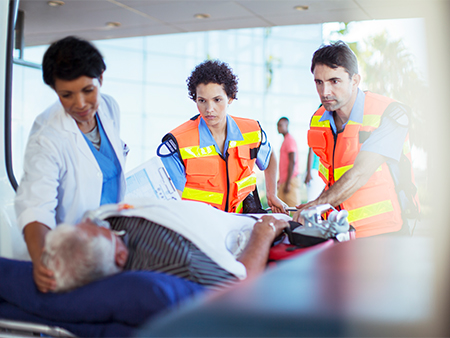 Out-of-hospital cardiac arrest was the third leading cause of health loss due to disease in the United States behind ischemic heart disease and low back/neck pain in 2016, according to new research in Circulation: Cardiovascular Quality and Outcomes, an American Heart Association journal. The study was led by researchers in the Department of Emergency Medicine, School of Medicine, at the University of Alabama at Birmingham.
Out-of-hospital cardiac arrest was the third leading cause of health loss due to disease in the United States behind ischemic heart disease and low back/neck pain in 2016, according to new research in Circulation: Cardiovascular Quality and Outcomes, an American Heart Association journal. The study was led by researchers in the Department of Emergency Medicine, School of Medicine, at the University of Alabama at Birmingham.
This groundbreaking study is the first to estimate disability-adjusted life years, or DALY, among victims of non-traumatic out-of-hospital cardiac arrest survivors in the United States. DALY measures the sum of years of life lost prematurely and years lived with disability due to a disease.
Cardiac arrest is an abrupt loss of the heart’s ability to pump, which leads to death within minutes if not treated. While it is known that sudden cardiac arrest is the third leading cause of death in the United States, responsible for more than 450,000 deaths annually, its effect on years lost to premature death and disability is currently unknown.
Using the national CARES — Cardiac Arrest Registry to Enhance Survival — database, researchers examined 59,752 cases of adult, non-traumatic, Emergency Medical Services-treated out-of-hospital cardiac arrest from 2016.
Among the findings:
- Disability-adjusted life year rates for out-of-hospital cardiac arrest were 1,347 per 100,000 individuals, ranking it as the third leading cause of health loss due to disease in the United States behind ischemic heart disease (2,447) and low back and neck pain (1,565).
- Individuals who experienced out-of-hospital cardiac arrest lost an average of 20.1 healthy years.
- At the national level, this resulted in 4.3 million healthy life years lost, representing 4.5 percent of total DALY in the country
Researchers also measured the effects of bystander intervention – CPR and automated external defibrillator application – on the disease burden of out-of-hospital cardiac arrest. Focusing their analysis on a subpopulation of bystander-witnessed out-of-hospital cardiac arrest events, researchers found that on a national level survival to hospital discharge was higher for those who received bystander CPR than for those who did not (21.5 percent vs. 12.9 percent). Bystander CPR alone was associated with 25,317 healthy life years saved and CPR paired with AED defibrillation was associated with 35,407 healthy life years saved.
“The majority of cardiac arrests occur outside of the hospital, and our results show that bystander interventions reduce death and disability, underscoring the importance of bystander CPR and AED education, as well as national cardiac arrest surveillance,” said Ryan A. Coute, D.O., lead study author and Emergency Medicine resident at the University of Alabama at Birmingham.
Furthermore, the researchers hope that this study may help focus public health policies, resources and future research on resuscitation science.
“Cardiac arrest is unique because survival is dependent on the timely response of bystanders, medical dispatch, EMS personnel, physicians and hospital staff,” Coute said. “We hope that the results of our study provide an opportunity to emphasize the fact that ‘cardiac arrest’ and ‘heart attack’ are not synonymous. Our results may also help inform funding agencies and policy makers regarding how to best utilize limited resources to improve public health.”
The researchers noted that women tended to have higher DALY values than men, as well as Caucasians compared to African Americans. Additionally, Hispanic race was associated with higher DALY compared with Caucasians.
“This is an important study that breaks new ground in our understanding of the toll that out-of-hospital cardiac arrest has on society,” said Michael Kurz, M.D., an associate professor of emergency medicine at UAB and a study co-author. “It is particularly significant that the research was led by Dr. Coute, a young investigator who was recruited to UAB for residency to prepare for a research career in resuscitation science — a somewhat overlooked field, but one that holds tremendous promise for improving the health and lives of millions of Americans.”
Co-authors are Brian H. Nathanson, Ph.D., OptiStatim LLC; Ashish Panchal, M.D., Ph.D., Ohio State University; Michael C. Kurz, M.D., UAB; Nathan L. Haas, M.D., University of Michigan; Bryan McNally, M.D., Emory University; Robert W. Neumar, M.D., Ph.D., University of Michigan; and Timothy J. Mader, M.D., University of Massachusetts Medical School–Baystate.